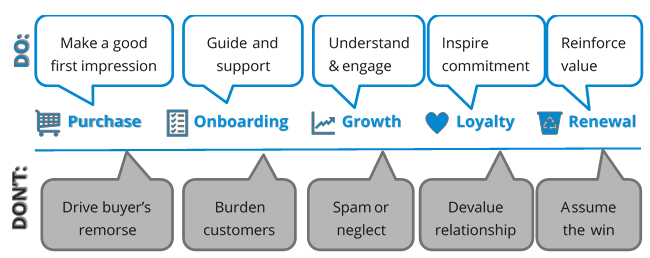Companies know that it is far more profitable and far less costly to sell to existing customers than it is to acquire new ones. To realize this benefit, customer attrition must be controlled.
There are five common points across the customer lifecycle where companies are at risk of losing customers.

Below, we review those points, common vulnerabilities, and how companies can control attrition.
1. Purchase
When a customer makes their first purchase, that initial product or service experience has an outsized impact. Customers are fresh from considering their options, comparing prices, reading reviews, getting input from social media. Their expectations are set.
When experience does not match those expectations, companies will see either high returns or cancellations. They likely won’t see that customer again.
When a second choice has been identified, it is far too easy to opt for the alternative if the first choice is a dud.
That first impression includes the complete experience: transaction ease, accurate charges, timely delivery, and presentation. Everything along this purchase and delivery chain either confirms or negates customers’ expectations.
As an example, Apple presents iPhones beautifully in its package design. That first impression compelled this customer to whisper, “Pretty.”
Compare that to a product that is tossed indifferently into a box. That may get dropped in a puddle. If the company doesn’t value its product, the customer won’t either.
2. Onboarding
This common attrition point is like the initial purchase because it confirms or negates expectations. Onboarding is a protracted first impression where necessary information is exchanged.
That exchange can include requirements, contracts, or technical and training specifications, or to fully define the kitchen remodel, for example.
Through this exchange, customers get clarity about how easy or painful it will be to work with the company. Will they make the customer do all the work? Will they ask the same questions over and over? Will they disappear after taking payment?
If customers experience friction in the early experience, it resets their expectations for the relationship. If that friction is unacceptable, they will exit.
3. Growth
Following the first purchase, there is great opportunity with existing customers.
So many companies emphasize customer acquisition but plain neglect existing customers. These companies often fail to understand customers’ needs or interests. They fail to direct and support customers’ consideration of a complementary product or service, or to recognize valuable opportunity at a milestone life event. Instead, they neglect customers, or pester them with spam that can drive them away.
4. Loyalty
Loyal customers represent tremendous revenue potential with equivalent risk. When customers are loyal, there is an attachment that is often emotional. When customers are neglected or mistreated, the response can be extreme because of that emotion. Loyalty can be tricky.
Consider United Airlines and the number of loyal customers who defected, and then berated on Twitter and Facebook, or otherwise voiced their outrage about the unacceptable treatment of a passenger that could have easily been them.
Companies often experience loss from more than one of these attrition points. I worked with a client who was hemorrhaging at all points in the customer lifecycle.
Diagnosis revealed a common symptom: they let customers do all the work. Customers educated themselves, committed tons of time at onboarding, figured out if additional products were helpful, and dealt with frantic phone calls at renewal.
The cure required engaging and supporting customers. It worked: revenue increased and costs dropped substantially.
Obviously, the bar should be set higher than not physically dragging customers off. For growth, companies must understand customers’ needs, but loyalty requires that companies additionally show appreciation to mirror emotional commitment.
5. Renewal
For companies with a subscription model, recurring revenue is lifeblood. However, if companies take a set-it-and-forget-it approach, they will inevitably see increasing attrition.
This adds pressure to the sales team to acquire replacement customers. That drives up budget, and drives down revenue and margins.
So often companies fail to monitor customer usage of their subscribed product or service. If the customer is not logging in or is not consuming, they likely don’t see value and won’t renew.
When companies reemerge only at renewal time, they have likely already lost the customer.
Customer attrition can be costly—and even fatal. Recognizing the common points that drive up the attrition rate is necessary. However, companies must additionally understand their customers and what they need at each step in order to optimize those relationships. When companies address contributors to attrition, they will enjoy growth opportunities, and the increased revenue and decreased costs that result.
Would you like to discuss customer intelligence? Measurable strategy? Or how to meet revenue goals? Let’s talk! Set up a 30-minute phone conversation with Marina.
Photo credit: Kev Seto

